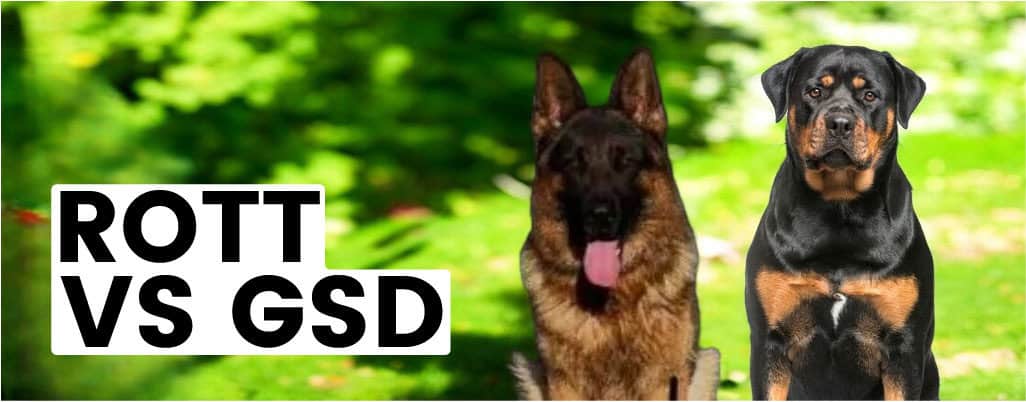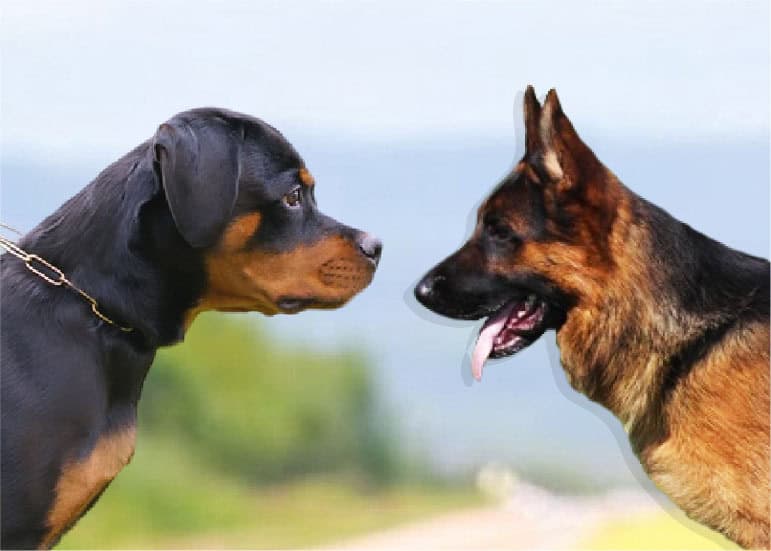
Are you considering a loyal companion but stuck on the decision between ROTT vs GSD? We know this won’t be easy.
When it comes to choosing between a Rottweiler (Rott) and a German Shepherd (GSD), remember you are not just picking a pet; you are selecting a loyal companion with a rich history and distinctive traits.
Both breeds are renowned for their intelligence, strength, and protective instincts, making them excellent choices for families and individuals alike. But what really sets them apart?
This post is about the key differences between Rottweilers and German Shepherds, from their physical attributes and temperaments to their training needs and compatibility with family life.
SUMMARY
- The key traits, behaviors, and temperaments of German Shepherds and Rottweilers.
- Discusses the training requirements for both breeds, highlighting the German Shepherd’s versatility and the Rottweiler’s strong protecting instincts.
- Learn about each breed’s common health issues and average lifespans, along with tips on ensuring a healthy life for their dogs.
- Guidance on which breed suits various living environments and owner lifestyles.
Rottweiler vs. German Shepherd – Quick Comparison of Both Breeds
Get a quick insight into the basic differences between ROTT and GSD.
| Feature | Rottweiler (Rott)🐾 | German Shepherd (GSD)🐾 |
|---|---|---|
| Origins | Ancient Rome used for herding and protecting | Germany, originally bred for herding and later for police/military work |
| Size | Large, muscular build | Large, athletic build |
| General Weight | 80-135 lbs (36-61 kg) | After eating, take your puppy outside for a potty break. Praise and reward. |
| Height | 23-27 inches (56-69 cm) | 22-26 inches (56-66 cm) |
| Coat Type | Short, dense, and straight | Medium-length, double-coat |
| Socialization | Needs early socialization to avoid aggression | Requires socialization to prevent over-protective |
| Family Compatibility | Great with families when well-trained | Excellent with families, good with children |
| Best Suited For | Experienced dog owners, families needing a protective companion | Active families, working roles, and those seeking an intelligent, versatile dog |
7 Key Differences Between Rottweiler and German Shepherd

German Shepherds differ from Rottweiler in every aspect. Some of them are as follows:
1. Temperament – Protective ROTTs vs. Adaptive GSDs
Rottweilers possess firm devotion and strong protective behaviors. They are inherently cautious of strangers, so they make ideal protectors and defenders for your family. This breed is often seen as distant, but in reality, they are extremely friendly and faithful to you. Rottweilers are recognized for forming strong relationships with their family members and are always ready to protect them from any anticipated harm.
Their behavior is characterized by calm confidence, and they are often acutely aware of their surroundings. While they may appear menacing to others, Rottweilers are kind and loving with those they trust, especially youngsters, if properly taught from an early age.
German Shepherds, on the other hand, are an outstanding combination of intelligence, flexibility, and drive to please. Unlike Rottweilers, German Shepherds are more accessible and friendly, making them ideal for houses with frequent visitors or other pets.
CALL Michael and Jeannette Today!
Ready for Your Home – Trained, Loyal Adult German Shepherds for Sale!

According to Forbes Advisor,
“Their temperament is balanced and versatile, allowing GSDs to flourish in various roles, including loving household pets and highly proficient working dogs.”
They have a natural desire to work and are cognitively engaged, which, along with their pleasant attitude, makes them a more adaptable and dependable companion in various circumstances. Their ability to quickly assess events and respond accordingly qualifies them as superb defenders and kind and loving family members.
2. Physical Build: Rottweilers vs. Shepherds
Rottweilers represent the peak of power and strength. Many people are intimidated by their
- broad chest,
- muscular build
- formidable stance is intimidating to many
This breed’s appearance exudes authority and dominance, which is often enough to deter potential threats without any aggressive action.
Their coat is short, dense, and typically black, with well-defined rust markings, adding to their imposing presence. Their robust frame also means they require a confident handler who can manage their strength and ensure they are well-trained to prevent any undesirable behavior.
German Shepherds have a more athletic and nimble build, distinguished by their
- longer body
- slightly sloped back
- balanced proportions
This breed’s physical appearance is both charming and practical, letting them move quickly and gracefully. Their double coat of various hues is attractive and shields them from varied weather conditions, making them adaptable to different climate conditions.
German Shepherds’ physical versatility demonstrates their adaptability; they can sprint, jump, and move easily, so they are frequently seen succeeding in Dog Sports, Search and Rescue, and Law Enforcement. Their appearance is more than simply their looks; it is the right balance of form and function that allows them to accomplish a wide range of duties with accuracy.
3. Intelligence: ROTT Focus vs. GSD Agility
Rottweilers are undoubtedly sharp, with an exceptional ability to learn and complete activities requiring concentration and determination. They thrive in occupations that need problem-solving skills, such as safety and protection duties. Their brilliance is frequently combined with a strong personality, which means they might be stubborn if they perceive a lack of leadership.
Patience, consistency, and an awareness of Rottweiler’s freedom are all required while training them. Though they are quick learners, they may not always be willing to obey directions until they recognize the benefit in them. This breed’s intellect is best used with a stern but positive attitude, as they flourish when they understand why they’re being asked to accomplish something.
German Shepherds are the most intellectual dog breeds, and they learn quickly. Their fast thinking, along with their great trainability, sets them apart in practically any scenario. German Shepherds thrive at learning complex commands, functioning under stress, and adapting to new settings.
Unlike Rottweilers, German Shepherds are intelligent and tremendously motivated to impress you, and training them gives you a more gratifying experience. They learn new commands easily and remember what they know. This makes them perfect for advanced obedience training, specialized tasks, and even competitive dog sports.
4. Exercise Demands: GSDs vs. ROTTs
Rottweilers are sturdy, muscular pets who need an ongoing schedule of exercise to remain healthy and happy. They love to do activities that challenge both their minds and bodies, such as walking, jogging, and tug-of-war. Rottweilers also have a quiet side and can be satisfied with moderate daily exercise. They are energetic but not at the same intensity as some other breeds. Rottweilers can become bored and show negative traits if they do not receive enough exercise and mental stimulation.
A well-bred, pure-bloodline German Shepherd typically exhibits a balanced temperament, making them ideal for family integration. These dogs possess a moderate energy level, meaning they thrive with regular, moderate exercise rather than intense or excessive physical activity. It’s important to match their exercise to their health and energy levels to maintain their well-being.
For German Shepherd puppies, particularly in their first year, careful attention must be given to their physical activities. Excessive exercise during this critical growth phase can lead to joint and bone problems later in life. Instead, it’s advisable to focus on gentle and controlled activities that support their development without overwhelming their still-forming skeletal structure. This approach helps lay a strong foundation for their physical health as they grow.
CALL Michael and Jeannette Today!
Train with the Best – Elite German Shepherd Schutzhund/IPO Training in Los Angeles!

5. Grooming and Shedding: ROTTs vs. GSDs
Rottweilers do not need much maintenance. Their short, dense coat requires little maintenance, usually only a weekly brushing to remove loose hair and maintain the coat shining. They shed moderately over the year, with some increase during seasonal changes. This makes them a sensible choice for pet owners who like dogs that don’t need much grooming.
Their short coat allows them to pick up less dirt and trash than longer-haired varieties. Basic grooming procedures like frequent washes, nail trimming, and ear cleaning are still necessary to keep them healthy and comfortable.
While the double coat of German Shepherds demands more maintenance, their outer coat is bulky and water-resistant, but their undercoat is softer and intended to provide insulation against the weather.
True German Shepherds are known to shed, but when provided with a high-quality, minimally processed diet rich in essential nutrients, their shedding can be significantly reduced. It’s a common misconception that frequent grooming is beneficial for their coat; however, excessive grooming can actually damage their fur.
Over-grooming can strip the coat of its natural oils, leading to dry, brittle fur and potentially causing skin irritations or other serious issues. To maintain a healthy coat and skin, a routine of weekly brushing is advised to help remove loose undercoats without causing harm. Bathing should be limited to once every three months unless the dog becomes particularly dirty or smelly in between. This regimen not only keeps the coat in excellent condition but also reinforces the natural protective qualities of their fur.
6. Health and Lifespan: Rottweilers vs. Shepherds
Rottweilers are robust and healthy dogs, but like all breeds, they are prone to certain health issues. Common health concerns include
- Hip
- Elbow dysplasia
- Heart problems
- Certain types of cancer
Their broad stature and powerful physique make them prone to degenerative joint problems, particularly as they age. Rottweilers usually live for 8 to 10 years. While they have a shorter lifespan than some other breeds, with proper care, they may enjoy a long lifespan. To avoid obesity, which may cause health problems, you should do frequent vet examinations, maintain a nutritious diet, and ensure they get enough exercise.
German Shepherds are generally healthy dogs with a lifespan of 9 to 13 years, but they are also predisposed to certain health issues. The most common concerns include
- Hip
- Elbow dysplasia
- Degenerative myelopathy
- Gastric dilatation-volvulus (bloat)
They are more vulnerable to injuries because of their active nature. You can manage these hereditary health risks with regular veterinary care, a balanced diet, and proper exercise. German Shepherds tend to have a longer lifespan than Rottweilers, which means more years of companionship and love. Their health is also tied to their work ethic, keeping them physically and mentally active.
Related: How to Properly Position GSD Hips For X-Ray?
7. Cost Factors: ROTTs vs. German Shepherds
Rottweilers are affordable relative to the initial purchase cost, particularly from reputable breeders that guarantee the health and quality of their dogs. The size and potential health difficulties require more investment in the future, specifically for food, veterinary care, and training. Rottweilers are a popular breed, but selecting a breeder who puts health and temperament above profit is not that easy.
When choosing a Rottweiler, you should be ready to accept the responsibilities that come with having such a powerful and protective breed. The initial investment may be lower, but the commitment to their care and education is lifelong.
German Shepherds are relatively more expensive to purchase initially but are frequently regarded as great investments. The grooming, feeding, and frequent health tests make it a bit more expensive. However, their adaptability and ability to perform a variety of tasks, including family pets and working dogs, frequently justify the higher cost. German Shepherds are commonly accessible, but selecting a breeder that produces healthy, well-behaved dogs is critical.
So, Which Dog Should You Get, a German Shepherd or a Rottweiler?
The two breeds are completely different in so many aspects. If you need a powerful, loyal protector, then Rottweilers is definitely the best choice for you. One thing to keep in mind is that they have a short lifespan and require more training than GSD.
Similarly, if you are in search of a versatile, highly trained dog, then there is no other than a German Shepherd. They are affectionate, protective, and adaptable, making them excellent companions for families with children. Their slightly longer lifespan and robust health contribute to years of dedicated companionship.
Before making your decision, seek professional advice and spend time with both breeds to ensure you are making the best choice for your lifestyle and family.
FAQs
Which Breed is Better for First-Time Dog Owners?
German Shepherds are generally more suitable for first-time dog owners due to their high trainability, adaptability, and willingness to please. However, with proper training and socialization, a Rottweiler can also be a good choice for an experienced owner who can provide strong leadership.
Are German Shepherds or Rottweilers more aggressive?
Both breeds have protective instincts, but aggression is not inherent to either breed when properly trained and socialized. German Shepherds tend to be more approachable and social, while Rottweilers can be more reserved and cautious around strangers.
Do German Shepherds or Rottweilers Bark more?
German Shepherds are known for being vocal, especially when alerting their owners to potential threats. Rottweilers bark less frequently but will use their deep bark when necessary to guard their home. Proper training can help manage barking in both breeds.
So, whether you choose the steadfast protection of a Rottweiler or the adaptable intelligence of a German Shepherd, both breeds offer unique benefits to their owners. Consider your lifestyle, environment, and what you seek in a canine companion to make the best choice.






